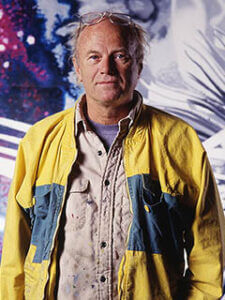James Rosenquist

James Rosenquist (1933-2017) was a renowned American artist best known for his pivotal role in defining the Pop Art movement of the mid-20th century. His work, characterized by the fragmentation and reassembly of images drawn from popular culture and advertising, provided a novel perspective on the American consumer society.
Born on November 29, 1933, in Grand Forks, North Dakota, Rosenquist exhibited an early aptitude for art. He studied at the University of Minnesota from 1952 to 1954 before moving to New York City, where he attended the Art Students League. To support himself during his early years in New York, Rosenquist worked as a billboard painter, an experience that profoundly influenced his later approach to scale and composition.
In the early 1960s, Rosenquist began to incorporate elements from billboards and commercial art into his paintings, drawing on his experiences as a sign painter. This period of his work culminated in 1965 with the creation of one of his most famous pieces, “F-111,” a sprawling, room-size painting that combined disparate images including a fighter jet, a light bulb, and a piece of cake.
Rosenquist’s art stood apart from his contemporaries due to his unique approach to Pop Art. Rather than portraying consumer items as they were, like Warhol and Lichtenstein, Rosenquist used a montage technique to create surreal, dream-like compositions that reflected the saturation and overload of the modern media landscape.
His career spanned more than five decades, during which he produced a prolific body of work that was exhibited worldwide. Rosenquist continued to push boundaries and experiment with new forms and concepts until his death on March 31, 2017.
In addition to his artistic achievements, Rosenquist was also an active advocate for artists’ rights. He served as a board member of the National Council on the Arts from 1978 to 1985, where he championed artists’ resale rights.
Rosenquist’s work remains influential in contemporary art, offering an evocative critique of consumer culture and mass media. His innovative combination of commercial and fine art techniques blazed a trail for future artists and cemented his legacy as a pioneering figure in the Pop Art movement.

